
|
|
13 March, 2000
Outdoor tour of Palmer Station.
Question 23: What is a "huddle" and how does it work?
We started off today with a short dive trip out to Hermit Island. The wind
is down and the water is very calm. There are tons of brash ice from the
glacier in the harbor and inlet. Getting through it with the boat is a long,
slow process. Glacier ice is very dense and could seriously damage the
motor's prop(eller) if we went quickly. At Hermit, Katrin and Chuck looked
for some specific types of macroalgae, and Ross and I collected Odontaster
for bioassays (see 3/22 journal for more information).
The rocky island shore slopes down past 91 feet (where we stopped) and is
covered with long red algae. Underneath the algae, all sorts of stars were
hiding! It was easy to find enough large ones. After sorting in the tank
room when we got back, we had a quick lunch, and Chuck and Bill went out for
an afternoon dive. We are also cataloging the organisms we collect, taking
pictures, making vouchers and herbarium samples. I will say more about the
records we keep at a later date.
The current Palmer station was built in 1968 and replaced a slightly older
station made of wood huts. It sits on a small protrusion of land, Gammage
Point, coming out from under Marr Glacier. It is separated from another spit
of land, Bonaparte Point, by Hero Inlet. Palmer is named for U.S. sealing
captain Nathaniel B. Palmer, one of the first people to see Antarctica. Many
of the islands around Palmer are closed to people from 1 October to 1 March
because of breeding birds in those areas. There is one island, Litchfield
Island, which is rated SSSI (a Site of Specific Scientific Interest) under the
Antarctic Treaty and which is always closed. We will be doing a marine and
intertidal survey around the edge of Litchfield.
The station is made up of a small collection of metal-sided buildings. The
two main ones are BioLab and GWR (Garage, Warehouse, Recreation.) These are
the two largest and where everyone lives. The third story of BioLab and
second story of GWR have housing, respectively, for 22 and 21 people. Right
now there are 45 on station, so we are a little crowded until the Gould and
Palmer return at the end of the month to take people away. On the colored map
below, BioLab and the aquarium lab are in blue. BioLab is in a "t" shape and
has three stories. The aquarium room with the saltwater tanks is the addition
that fits in behind the "t". The first story of BioLab has most of the lab
space. On the second story are the kitchen, cafeteria and offices.
GWR is the yellow building on the map. I live there. Also on the second
floor are the workout room and the recreation room with pool table, library
and TV/VCR with movies. Raised wooden walkways connect GWR and the various
levels of BioLab. They are great to get around on as the roadway here is very
muddy. The other building I spend a lot of time in is the Dive Locker, in red
on the map. This is where all of our gear is kept, where the air compressor
to fill the tanks is located, and where we get ready to dive and then clean up
afterwards. The brownish area is the dock and Zodiac mooring area.
The green circles are the huge white fuel tanks. Sometime when the weather
is good, there are "drive in" movies here (movies projected on the fuel
tanks). And lastly, the pink building is the pump house for the seawater used
in the lab and in the plumbing. Very important, but we don't spend much time
there!
Answer 22: The south polar skua; it has been seen at the South Pole. It raids
penguin colonies, as does the brown skua, and also feeds at sea, eating krill
and fish.
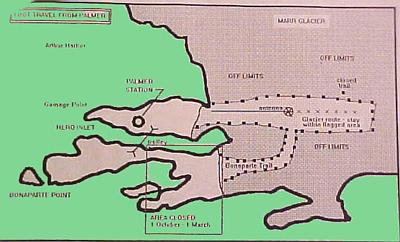
Gammage and Bonapart Points
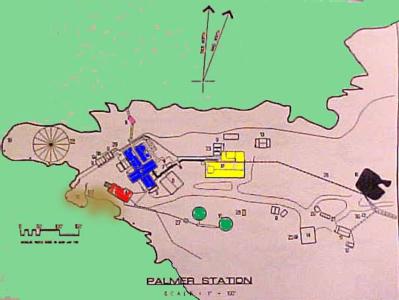
Palmer Station Map
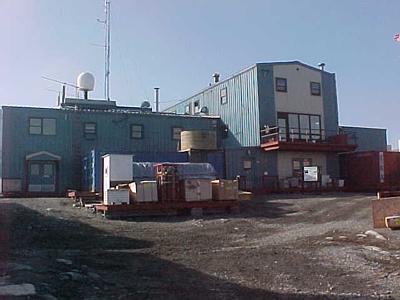
Front of Biolab building.
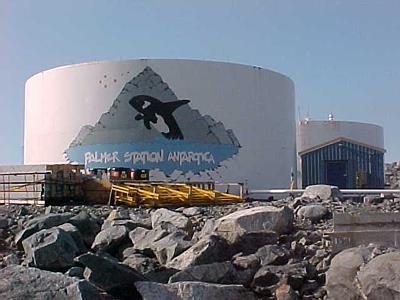
Fuel tanks
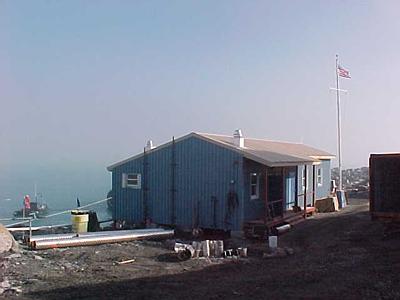
Dive locker and boathouse building.

GWR building with stair tower on left.

Pumphouse

Marr Glacier
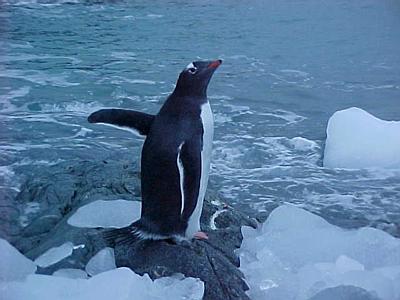
This evening, a Gentoo penguin came ashore right by the Biolab building!

Contact the TEA in the field at
.
If you cannot connect through your browser, copy the
TEA's e-mail address in the "To:" line of
your favorite e-mail package.
|
